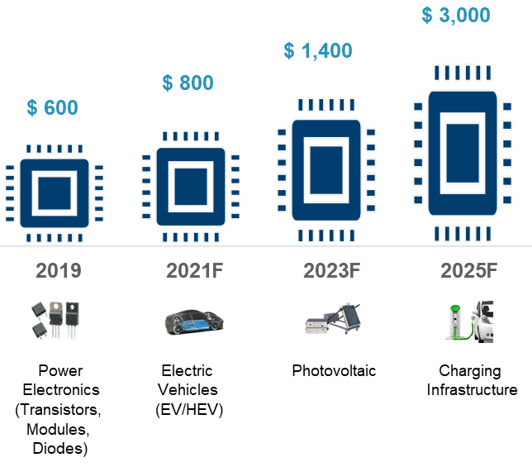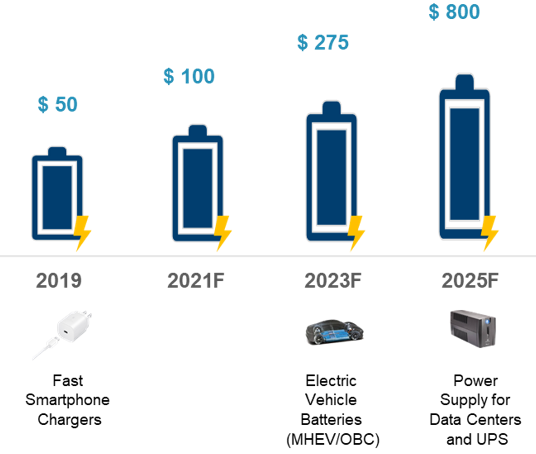Has COVID-19 Impacted the Growth Prospects for Wide Bandgap Materials?
Published on 01 Sep, 2020

The COVID-19 outbreak abruptly paused the supply chain for wide-band gap materials, however reoccurrence of demand green shoots in 2Q 2020, is likely to reset the market from a proverbial pause mode to an active fast forward stage as wafer suppliers mitigate the existing supply chain conundrum and plan for a longer haul in the semiconductor material market.
Power electronics devices such as diodes, thyristors, and transistors (MOSFET and IGBT) are steadily being adopted across various end-use sectors, boosted by key megatrends including climate change, government subventions, artificial intelligence, and recent technology developments. Consequently, steady penetration of silicon carbide and gallium nitride was anticipated in the market, for which key suppliers had increased their capacities to meet the growing demand. However, the abrupt slowdown of the global economy due to the COVID-19 pandemic impacted the overall growth trajectory of silicon carbide as well as gallium nitride, raising vital questions among suppliers – Will the pandemic have short- or long-term effects? How will suppliers respond to the supply chain challenges posed by this global pandemic?
Limitations of the conventional semiconductor material, i.e. silicon, led to a rapid rise of “wide bandgap” semiconductor materials, especially silicon carbide and gallium nitride. Both materials allow for greater power efficiency, smaller size (drive miniaturization), and lighter weight (volume reduction). These attributes enable the reduction in life-cycle costs across a wide range of applications, and permit wide bandgap material-based devices to operate at much higher temperatures, voltages, and frequencies compared with their conventional silicon-based counterparts.
However, the COVID-19 pandemic continues to severely affect the overall market. Lockdown measures imposed due to the pandemic have negatively impacted the overall growth potential of wide bandgap semiconductor materials, owing to supply restrictions as well as slump in adoption by end-use industries.
Demand for silicon carbide materials remains resilient supported by revival in automotive sector....
The biggest impact of the COVID-19 pandemic was on the demand for silicon carbide (SiC) semiconductor material, as all the major automotive OEMs had to halt their production temporarily (first in China, followed by other key regions such as Europe and North America). Demand was further impacted due to trade restrictions levied on inter-country imports and exports of SiC. Revenue generated from automotive power semiconductors applications plummeted to around USD250 million in 2020 from USD300 million in 2019.
Green shoots of demand growth were observed in 2Q20, with OEMs in China as well as a few regions in Europe resuming production. However, pain points related to component shortage and reduced workforce at production facilities are expected to persist for another two quarters, before production at OEM facilities reach full capacity.
On the supply side, the COVID-19 crisis had minimal impact on the production of SiC wafers, due to automation at production facilities and minimal workforce requirements. Manufacturers of SiC wafers have been facing the challenge of supply chain disruption. Wafer suppliers are primarily concentrated in the US and European regions. However, trade tensions between the US and China have affected the demand of end consumers located in China. This impact was further aggravated by the COVID-19 pandemic, which resulted in China accelerating its efforts to develop the SiC wafer industry.
To overcome this supply chain conundrum and ensure that cash flows can be maintained for the business, key SiC wafer manufacturers in the market are strategically focusing on local customers as well as alternative end-use segments.
.... While long term growth prospects for gallium nitride materials remain unaffected driven by demand from consumer electronics sector
Impact of the COVID-19 pandemic on gallium nitride (GaN) has been minimal, compared with SiC. Demand for GaN slightly dipped in 1Q20, primarily due to budget restrictions of end consumers, especially smartphone OEMs (as GaN-based devices are expensive). Consumer electronics account for more than 80% of the overall GaN semiconductor device market, i.e., around USD55 million. Furthermore, reduced consumer spending along with temporary closures of factories led to the decline in smartphone production by 20–30%.
The market witnessed growth from 2Q20, driven by uptick in the production of consumer electronics, especially smartphones. Furthermore, as China’s economy is closer to recovery compared with that of Europe and the US, major China-based OEMs such as Xiaomi, Huawei, and Vivo are steadily increasing their production utilization rates for GaN-based fast chargers.
Although demand for GaN faced certain production challenges due to lockdowns imposed worldwide, the supply side saw minimal impact on production due to automation at production facilities. However, similar to SiC, trade tensions between the US and China as well as the COVID-19 pandemic have gravely impacted the consumer electronics market in China. To mitigate the impact of trade restrictions, GaN semiconductor suppliers are strategically focusing on the domestic market by collaborating with local customers through long-term contracts.
Following a minor bump in demand due to COVID-19 pandemic, adoption of wide band gap will be expected to stay on track in the long term....
Although the emerging wide bandgap semiconductor market witnessed a steep fall in demand during 1–2Q20, it is anticipated to recuperate from the impact of the COVID-19 pandemic. Moreover, it will continue to increase at a CAGR of around 18–20% from USD370 million to USD900 million by 2025. Furthermore, rebound in sales of automotive and consumer electronics is envisioned by end users of wide bandgap semiconductor materials by early 2021 (based on countries’ ability to avoid the second wave of the COVID-19 outbreak through the development of vaccines and other treatments).
Road Map of SiC-based Devices |
Road Map of GaN-based Devices |
Hence, suppliers must plan strategically to develop capabilities to target growing end-use applications in the future. Based on our observations, the following tactical and strategic maneuvers can be undertaken by wide bandgap semiconductor material suppliers:
- Short term – Material suppliers should continue to focus on consumer electronics and telecommunication sectors (till the end of 3Q20), which witnessed minimal impact from the COVID-19 pandemic.
- Long term – SiC and GaN material suppliers should enhance their capacities and develop mass production facilities (especially for GaN) to cater to the growing power electronics sector in the future. Furthermore, these suppliers should collaborate with power semiconductor device manufacturers to develop newer application segments.



